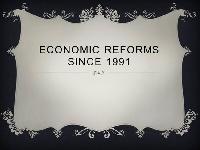
New economic reforms in India refers to the neo-liberal polices introduced by the government in 1991 and in the later years. The central point of the reforms was liberalization of the economy, simplifying regulations, giving more role to the private sector and opening up of the economy to competition. New industrial policy of 1991 is the heart of the new economic reforms. The philosophy of the new economic policy was enhancing competition based upon more market orientation. During the last twenty-five years, the economic reform has produced significant impact on the economy- mostly positive. Following are the main features of New Economic Reforms.
1. Dereservation of the industrial sector– the industrial sector of the economy has been opened up to the private sector after the New Industrial Policy of 1991. Previously, the public sector has given reservation especially in the capital goods and key industries. Other operators- private sector and foreign investors were not allowed in these critical industries. Deregulation of the industrial sector allowed private sector operation in most of these sectors except in eight selected areas including atomic energy, mining and railways.
2. Industrial delicensing policy: the most important part of the new industrial policy of 1991 was the end of the industrial licensing or the license raj or red tapism. Under the previous industrial licensing policies, private sector firms have to secure licenses to start an industry. This has created long delays in the startup of industries. The industrial policy of 1991 has almost abandoned the industrial licensing system. It has reduced industrial licensing to fifteen sectors.
3. Opening up of the economy to foreign competition: another major feature of the economic reform measure was that it has given welcome to foreign investment and foreign technology. Opening up of the economy to foreign competition started a new era in India’s economic policy with permission to FDI upto 51 per cent in selected sectors.
4. Liberalization of trade and investment: the economic reforms introduced extensive liberalization of foreign trade and foreign investment. The import substitution and import restriction policies were abandoned and instead import liberalization and export promotion policies were introduced. On the investment front, the economic reforms mark the era of capital mobility in the country. Foreign capital in the form of FDI (Foreign Direct Investment) and FPI (Foreign Portfolio Investment) were entered into our country.
5. Financial Sector Reforms: on the financial sector the government is introducing numerous measures for the deregulation as well as liberalisation of the sector. Different banking sector reforms including removal of control on interest rate and branch licensing policy liberalization were launched. Capital market reforms and money market reforms were extensive after 1994.
6. Reforms related to the Public sector enterprises: reforms in the public sector were aimed at enhancing efficiency and competitiveness of the sector. The public sector will be concentrating in key and strategic sectors. Government has adopted disinvestment policy for the restructuring of the public sector in the country along with several other policies.
7. Abolition of MRTP Act: The New Industrial Policy of 1991 has abolished the Monopoly and Restricted Trade Practice Act. In 2010, the Competition Commission has emerged as the watchdog in monitoring competitive practices in the economy.
The economic reforms were started in 1991, and they are still continuing. A major feature of economic reforms was that it was implemented in a gradual manner. The reforms were comprehensive and extensive as it covered all sectors- trade, investment, industrial sector, financial sector, public sector, fiscal sector etc. The new industrial policy introduced in 1991 is the central point of the economic reforms. In the following years, the government has introduced further policy changes for trade liberalization, financial sector liberalization and foreign investment policy changes to sustain the momentum initiated in 1991. Over the last twenty-five years, as a result of the launch of the new economic policy and its continuation, the Indian economy has undergone significant improvement and now is one of the fastest growing economies in the world. The famous BRIC report predicts that India will grow as the second largest economy by 2050. At present, India is categorized as an Emerging Market Economy (EME) along with China, Brazil, Russia etc. Even in the current crisis phase of the global economy, India’s macroeconomic performance is comparatively better.
*********









